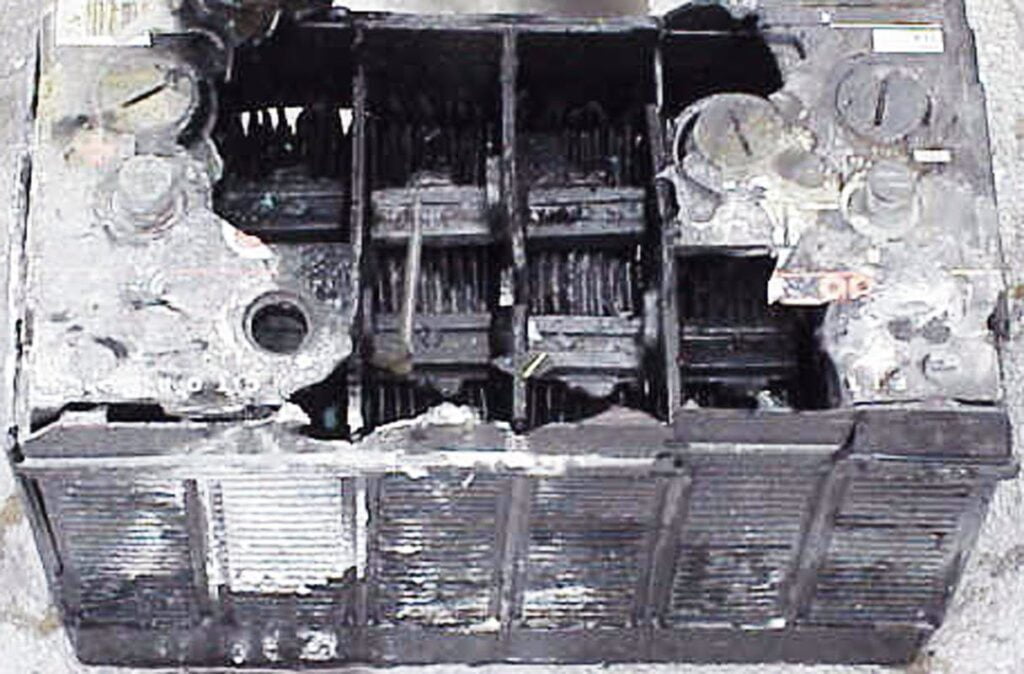by Collyn Rivers
Battery Ventilation
All lead-acid batteries, AGMs and gel cells, generate explosive gas. Even though most are sealed, makers stress that battery ventilation is vital still. Confusion exists over this. Around 2000, some battery makers began to claim that no ventilation was required. Or, ventilation is advisable but not necessarily essential. They withdrew this advice, however, shortly after. Many batteries thus have a warning notice as below.

Despite warning notices like this, many RV builders install batteries in unventilated compartments. In 2012, one threatened criminal defamation when I published that ‘battery ventilation is vital’. The company withdrew only when shown evidence the batteries they were fitting in their own products had such notices.
Explosion risk
Hydrogen lacks colour or smell. Without instrumentation, a human cannot detect it. Unsealed batteries smell whilst charging, but that odour is not hydrogen.
Many batteries have an acid/water mix called an electrolyte. If overcharged, that liquid produces explosive hydrogen. In a typical battery enclosure with about 10 litres of free air space, a 10% (explosive) concentration builds up within 60 seconds. When mixed with air, ignited hydrogen typically starts fizzling at a concentration of about 4%. If the concentration exceeds 10% a tiny spark causes it to explode.
Sealed batteries cope with low levels of overcharging. To prevent an explosion, they have normally sealed vents. These open when pressures reach dangerous levels. As long as the batteries are ventilated (and there is no source of ignition) this gas typically dissipate harmlessly.
Lead-acid battery explosion is rare. It can however blow an RV apart. One (Australian) RV maker, whose product lacked ventilation, blew out the floor of his very own, through just that.
Assuring basic ventilation is so easy it seems ridiculous not to provide it. Let alone (as some do) to argue against it.

An exploded battery is an ugly sight. Pic: http://www.rayvaughan.com
Hydrogen only explodes when ignited. An almost invisible tiny spark, however, does so. Common sources include insecure terminal clamps and cables. Also, battery connectors that work-harden and crack. Sparks can also be caused by any electrical or moving device. Worn bearings may do so. Battery chargers, isolating relays etc, should never be installed in battery enclosures. Such battery ventilation is vital.
Venting details
The battery enclosure must enable fresh air to enter at its base. The (lighter) hydrogen must be able to escape to atmosphere via unrestricted outlets at the enclosure’s very top. The RV industry has no standards regarding this. General practice, however, is to provide a few 25 or so mm holes at the top. They are needed to the very bottom.
In 2003, the (then) Sustainable Energy Industry Association suggested the following minimum. The size given is for each vent (top and bottom).
Area in sq cm = 0.006 X ‘n’ X I.
Where ‘n’ – the total number of cells in the battery/s (for this purpose each cell is nominally 2.0 volts)
‘I’ = maximum charging rate in amps.
For example a travel trailer with two 12 volt batteries (each of 6 cells) and maximum charging rate might be 50 amps. Then A = 0.006 x 12 x 50 = 3.6 sq cm. The above is a minimum requirement. Ventilation can thus be one or two slots top and bottom. Each should be about 5 cm by 1 cm.
Naturally vented enclosures have been criticised. Decades of experience, however, indicate they are adequate. Wind, however, can generate areas of high pressure around exit vents. This can prevent gas from escaping. This is less of an issue if adequate lower vents are provided. But many an enclosure is vented only at the top. If yours is like that, cut a few holes at the very bottom.
LiFePO4 batteries
These batteries use a technology that is different from lead-acid. These batteries can and do explode. When they do, they typically emit dense white smoke. This strongly irritates and may harm the respiratory tract, mucous membranes, eyes, and skin. The electrolyte reacts with moisture to form hydrogen chloride and sulphur dioxide. Some also release bromine and chlorine. There are also fire risks if they are overcharged. This is due to the flammable properties of volatile organic substances.
So here too battery ventilation is vital. Vendors offer little advice re this. It seems prudent, however, to house them much as with lead-acid batteries. Ideally using fire-proof materials. (See also Article Lithium-ion batteries in travel trailers.)
Battery ventilation is vital – summary
There are no legally enforceable (RV) standards in this area. This article can thus only state that battery makers stress battery ventilation is vital. Some explain why.
There is little or no risk if batteries are housed in well-vented enclosures. With sealed batteries, the risk is not high. It exists however if they are within (say) a closed bed base that traps gas. Eliminating this risk consist of little more than cutting slots, or drilling holes. So why not do it?
Further information
For information on batteries and battery charging see: AGM batteries for travel trailers, Lithium-ion batteries in travel trailers, and Speeding battery charging from generators.
In-depth coverage of batteries and battery charging is included in my books Caravan & Motorhome Electrics, Solar that Really Works! (RV-related), and Solar Success (homes and properties). My other books are the Caravan & Motorhome Book, and the Camper Trailer Book. For information about the author please Click on Bio.
This topic often arises on RV forums. If you feel this article might assist others, please consider posting this Link to it on the relevant forum thread.




